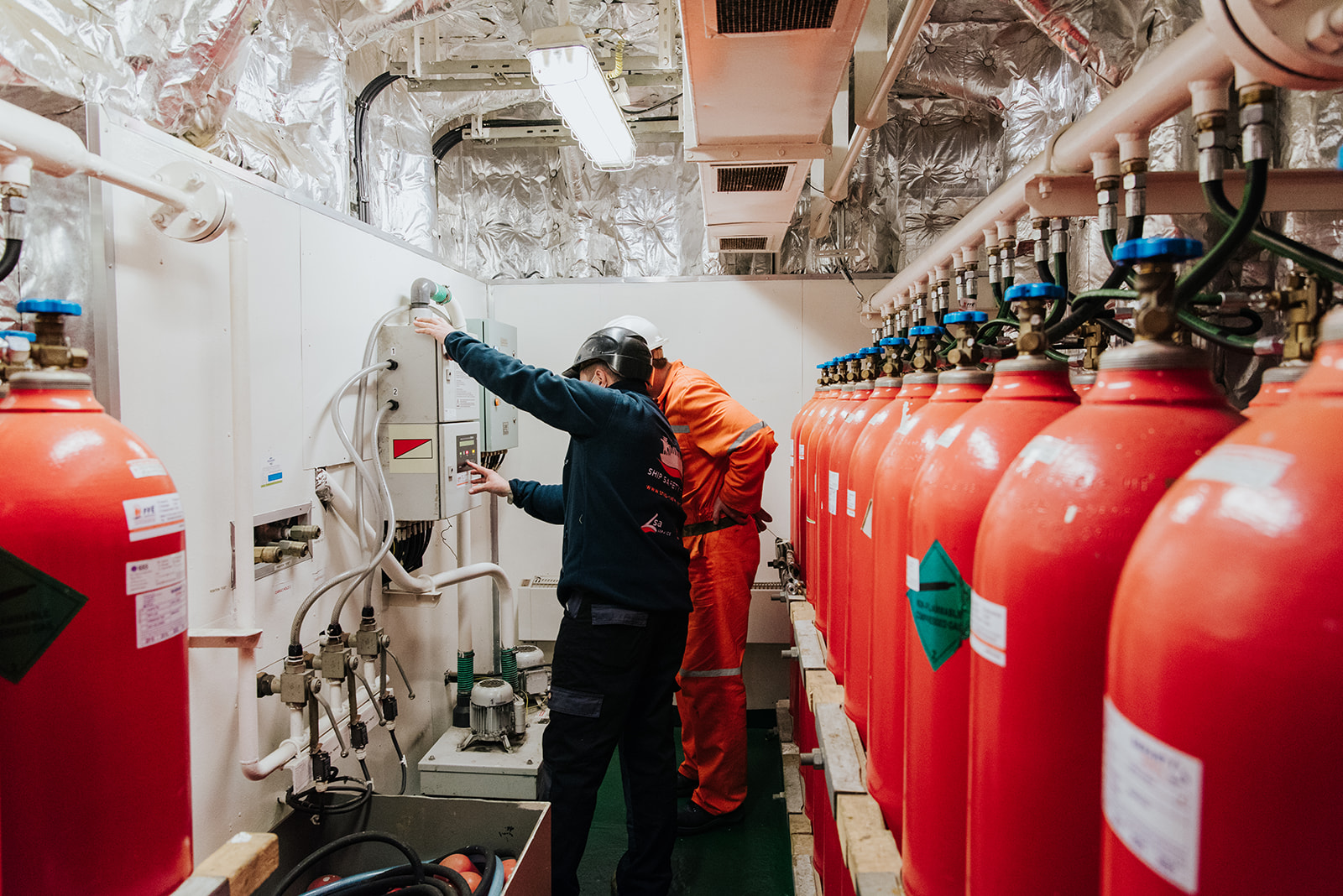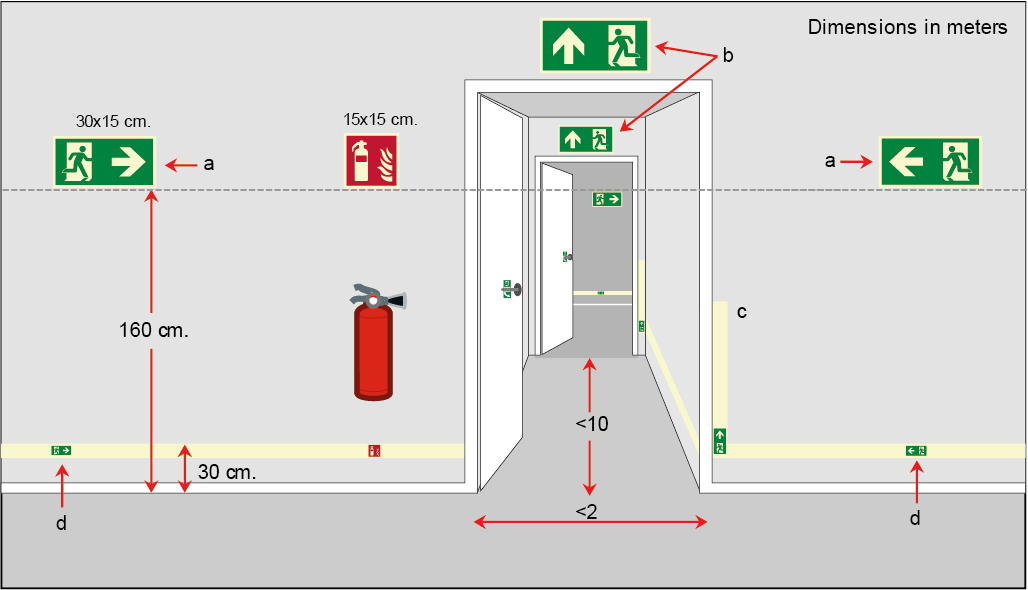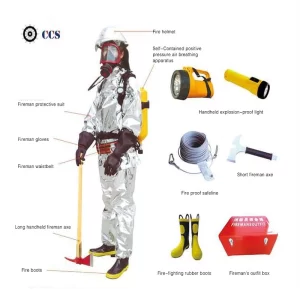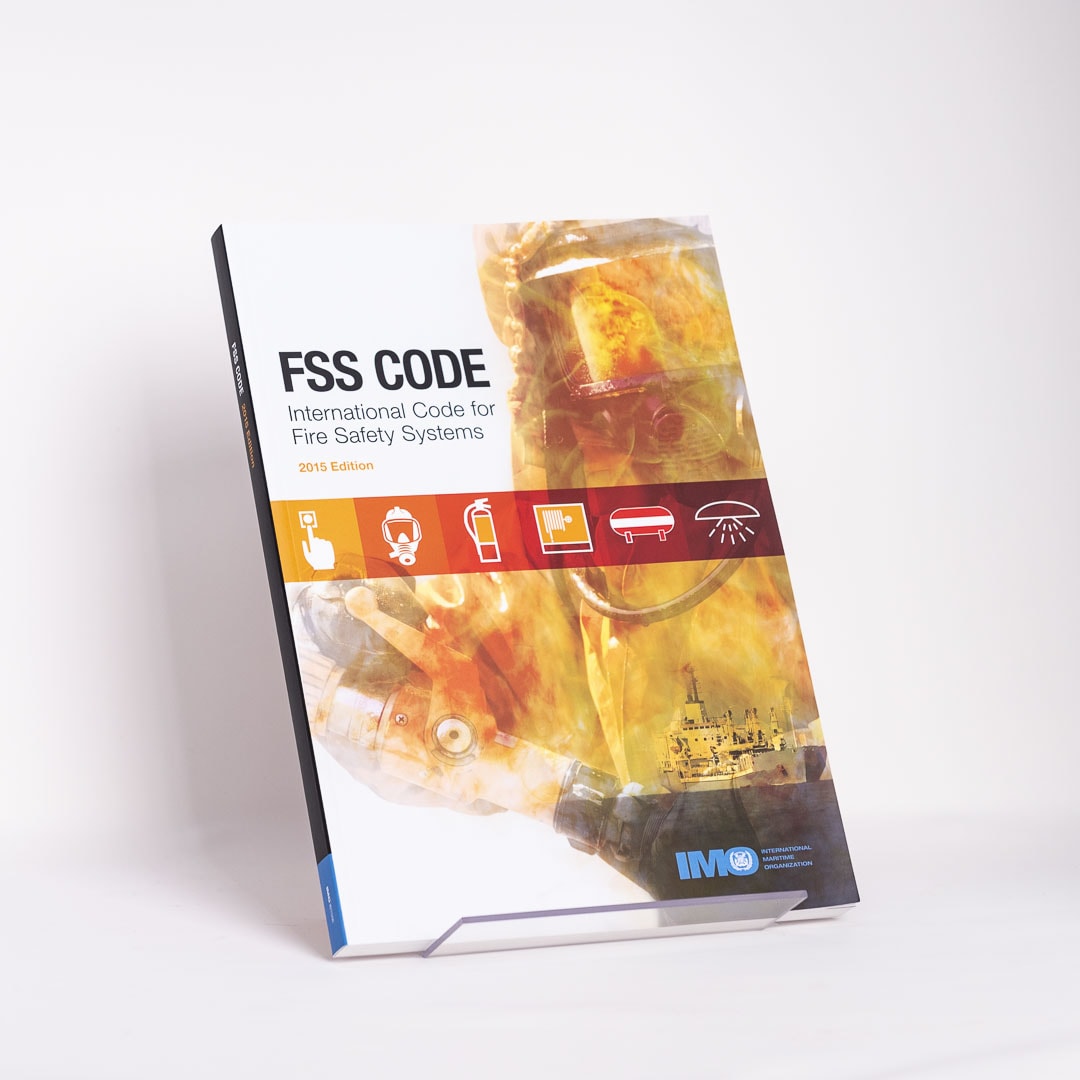Fire on ships is a serious hazard that can lead to catastrophic damage, endanger lives, and threaten the vessel’s safety. To mitigate risks, ships are equipped with fire safety systems, including alarms, extinguishers, and emergency protocols, as governed by international regulations like the Fire Safety Systems (FSS) Code. Proper training and regular maintenance are essential to prevent and manage onboard fires effectively.
The Fire Safety Systems (FSS) Code is a crucial component of maritime safety, providing comprehensive guidelines for the fire protection, detection, and extinction systems on ships. Enforced under the International Convention for the Safety of Life at Sea (SOLAS), the FSS Code is essential for ensuring the safety of vessels, their crew, and cargo. This article aims to provide ship students and cadets with an in-depth understanding of the FSS Code, its significance, and its detailed application on ships.

Overview of the FSS Code
The FSS Code, initially adopted by the International Maritime Organization (IMO) in 2000, is periodically updated to incorporate advancements in fire safety technology and lessons learned from maritime incidents. The code outlines the requirements for fire safety systems and equipment on ships, including:
- Fire Main Systems
- Fixed Fire Extinguishing Systems
- Fire Detection and Alarm Systems
- Smoke Control and Ventilation Systems
- Means of Escape
- Firefighters’ Outfits
Each chapter of the FSS Code details specific requirements for these systems, ensuring they are capable of addressing various fire scenarios on board.
—
Key Components of the FSS Code
1. Fire Main Systems
Fire main systems are the backbone of a ship’s firefighting capability, providing a reliable source of water for firefighting throughout the vessel. The FSS Code specifies the design, installation, and maintenance of these systems to ensure they are always operational and effective.
Design and Construction: The fire main system must be capable of delivering a sufficient quantity of water under adequate pressure to multiple hydrants simultaneously. The system typically includes sea water intakes, fire pumps, and a network of pipes and hydrants strategically located around the ship.
Fire Pumps: Ships are required to have at least two independently powered fire pumps. These pumps should be able to deliver water at a pressure of at least 0.27 N/mm² through any two fire hydrants.
Hydrants and Hoses: Fire hydrants should be distributed to ensure every part of the ship can be reached with at least two streams of water from separate hydrants. Fire hoses must be of a durable material, long enough to cover the necessary areas, and equipped with nozzles that can produce both solid and spray streams.
Maintenance and Testing: Regular maintenance and testing are required to ensure the fire main system’s functionality. This includes checking for leaks, verifying pump operation, and ensuring hoses and nozzles are in good condition.

2. Fixed Fire Extinguishing Systems
Fixed fire extinguishing systems are installed to quickly and effectively suppress fires in specific areas of the ship, such as engine rooms, cargo holds, and galleys.
CO2 Systems: Carbon dioxide (CO2) systems are commonly used for engine rooms and cargo spaces. These systems work by flooding the protected space with CO2, which displaces oxygen and suppresses the fire. The FSS Code specifies the quantity of CO2 required based on the volume of the protected space, the arrangement of CO2 cylinders, and the controls for safe and effective discharge.
Foam Systems: Foam fire extinguishing systems are particularly effective for flammable liquid fires. They create a blanket of foam that smothers the fire and prevents re-ignition. These systems are commonly used in engine rooms and areas where fuel is stored or handled. The FSS Code outlines the types of foam agents permitted, the required concentration, and the application rates.
Water Mist Systems: These systems use fine water sprays to control, suppress, and extinguish fires. Water mist systems are effective for a wide range of fire types, including electrical fires. The FSS Code details the design and performance criteria for these systems, ensuring they provide rapid cooling and fire suppression with minimal water damage.
Installation and Maintenance: Fixed fire extinguishing systems must be installed according to stringent standards to ensure their effectiveness. Regular maintenance, including system checks, cylinder pressure tests, and discharge tests, is required to maintain operational readiness.

Fixed CO2 Fire Extinguishing Systems
3. Fire Detection and Alarm Systems
Early detection of fires is crucial for minimizing damage and ensuring the safety of personnel. The FSS Code mandates the installation of automatic fire detection and alarm systems in accommodation areas, service spaces, and control stations.
Detector Types: Fire detection systems typically include smoke detectors, heat detectors, and flame detectors. Each type is suited to different environments and fire hazards. Smoke detectors are used in areas where early detection of smouldering fires is essential, while heat detectors are used in areas where rapid temperature increases occur.
System Configuration: The detection system must be arranged so that any fire is quickly detected and the alarm is promptly activated. This includes zoning the ship into fire detection zones that correspond to fire control boundaries and ensuring that alarms provide clear information about the location of the fire.
Alarm and Notification: Fire alarm systems must alert both the crew and passengers. The alarms should be audible and visual, ensuring they can be perceived in all areas, including high-noise environments. Integration with the ship’s public address and general alarm systems is essential for effective emergency communication.
Maintenance and Testing: Regular testing and maintenance are required to ensure the reliability of fire detection systems. This includes routine checks of detectors, alarm sounders, control panels, and system wiring.

Ship alarm system – Praxis Automation Technology – fire
4. Smoke Control and Ventilation Systems
Proper ventilation and smoke control are vital for maintaining visibility and breathable air during a fire. The FSS Code requires the installation of smoke extraction systems and fire dampers to control the spread of smoke and maintain safe evacuation routes.
Smoke Extraction Systems: These systems are designed to remove smoke from corridors, stairwells, and other escape routes, improving visibility and reducing inhalation hazards. The FSS Code specifies the capacity and arrangement of smoke extraction fans and ducts.
Fire Dampers: Fire dampers are installed in ventilation ducts to prevent the spread of fire and smoke between compartments. They are designed to close automatically upon detection of smoke or heat. The code outlines the standards for fire dampers’ construction, installation, and maintenance.
Pressurization Systems: In certain areas, such as stairwells and escape routes, pressurization systems prevent smoke from entering. These systems create a higher pressure in protected areas, keeping smoke out.
Maintenance and Testing: Regular testing and maintenance of smoke control and ventilation systems are essential. This includes checking the operation of extraction fans, fire dampers, and pressurization systems to ensure they function correctly in an emergency.

An Overview of the Ship Ventilation Systems
5. Means of Escape
Ensuring that all personnel can safely evacuate the ship in the event of a fire is a critical aspect of the FSS Code. The code specifies the number, type, and location of escape routes and emergency exits, along with the provision of emergency lighting and signage.
Escape Routes: The FSS Code requires a sufficient number of escape routes from all parts of the ship, ensuring that no area is left without a means of evacuation. Primary and secondary escape routes must be clearly marked and unobstructed.
Emergency Exits: Emergency exits must be strategically located and easily accessible. They should be clearly marked with illuminated signs and provided with emergency lighting to ensure visibility during power outages.
Emergency Lighting: Emergency lighting is crucial for illuminating escape routes and exits. The FSS Code specifies the required duration, intensity, and arrangement of emergency lighting systems.
Evacuation Plans: Detailed evacuation plans and procedures must be posted in accessible locations throughout the ship. Crew members should be trained in these procedures and participate in regular drills to ensure preparedness.
Maintenance and Testing: Regular checks and maintenance of escape routes, emergency exits, and emergency lighting systems are required to ensure they remain functional and effective.

Safety Sign regulations
6.Firefighters’ Outfits
The FSS Code mandates that ships carry a specified number of firefighters’ outfits, including protective clothing, breathing apparatus, and other firefighting equipment. These outfits enable crew members to safely combat fires and perform rescue operations.
Protective Clothing: Firefighters’ protective clothing includes heat-resistant suits, gloves, boots, and helmets. These are designed to protect against high temperatures, flames, and hazardous materials.
Breathing Apparatus: Self-contained breathing apparatus (SCBA) provides firefighters with a supply of breathable air, allowing them to operate in smoke-filled environments. The FSS Code specifies the required capacity and performance standards for SCBA units.
Additional Equipment: Firefighters’ outfits also include equipment such as fire axes, portable radios, and thermal imaging cameras. These tools are essential for effective firefighting and rescue operations.
Storage and Maintenance: Firefighters’ outfits and equipment must be stored in accessible locations and maintained in a state of readiness. Regular inspections and maintenance are necessary to ensure all components are functional and meet safety standards.

Credit: Chinaxhmarine
The FSS Code is regularly updated to reflect new technological advancements and enhance fire safety measures. Recent amendments include:
Improved Fire Detection Technologies: The integration of advanced fire detection technologies, such as infrared and video smoke detection systems, to improve early fire detection and reduce false alarms.
Enhanced Fixed Fire Extinguishing Systems: Updates to the standards for fixed fire extinguishing systems, including new requirements for water mist and foam systems, to increase their effectiveness and reliability.
Strengthened Training Requirements: Enhanced training requirements for crew members, ensuring they are proficient in using fire safety equipment and conducting emergency procedures.
The FSS Code is a vital framework for ensuring fire safety on ships. By adhering to the code’s requirements, ship operators can significantly reduce the risk of fire incidents and enhance the safety of their vessels and crew. For ship students and cadets, understanding the FSS Code is essential for their future roles in maintaining and operating safe maritime environments. Staying informed about the latest updates and advancements in fire safety technology is crucial for ongoing maritime safety.
By: Dr Reza Karimpour
To evaluate your knowledge about the FSS Code, with a focus on the above article, please answer the following questions:
- What are the primary objectives of the Fire Safety Systems (FSS) Code, and how does it contribute to maritime safety?
- How do the design and construction of fire main systems ensure effective firefighting capabilities on ships?
- What are the specific requirements for the installation and maintenance of CO2 fire extinguishing systems under the FSS Code?
- In what ways do foam fire extinguishing systems differ from water mist systems, and what are their respective advantages in maritime fire safety?
- How does the FSS Code ensure early detection of fires through the use of various types of fire detectors, and why is this important?
- What are the key components of a ship’s fire detection and alarm system, and how do they work together to provide comprehensive fire monitoring?
- How do smoke control and ventilation systems function to maintain safe conditions during a fire, and what are the specific requirements for their maintenance?
- What measures does the FSS Code specify to ensure safe and effective means of escape for all personnel on board a ship?
- What are the essential elements of firefighters’ outfits according to the FSS Code, and how do they enhance the safety and effectiveness of firefighting operations on ships?
- How do recent updates and amendments to the FSS Code improve fire safety on ships, and what new technologies or practices have been integrated?


Thank you!
your article is usefull for me, thank you.
Very good!